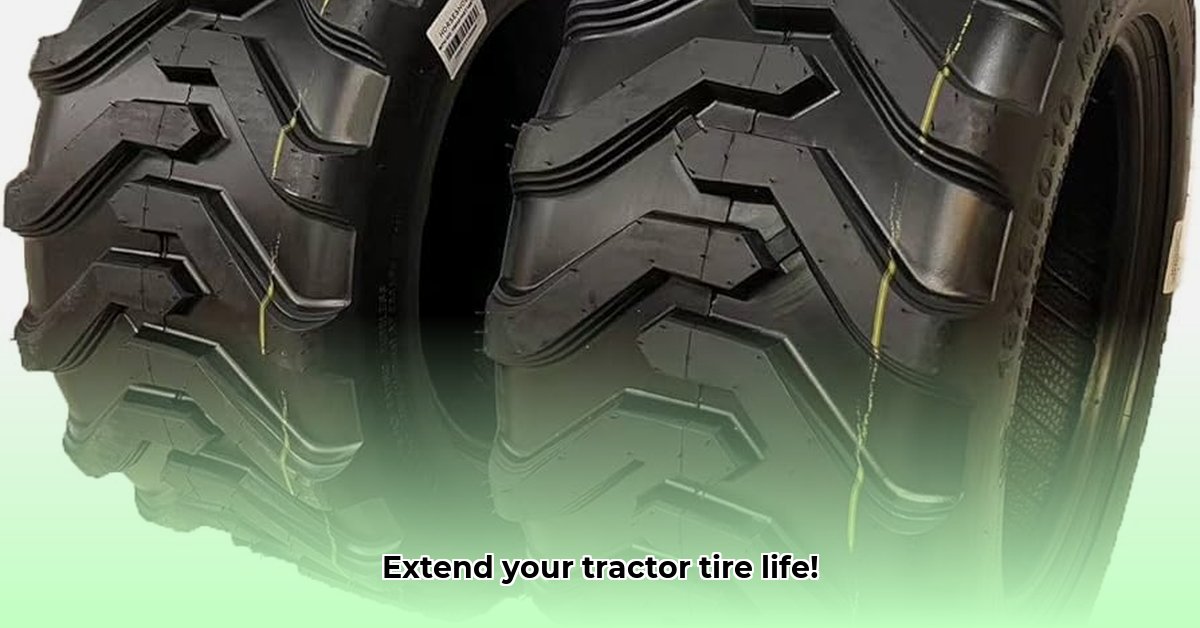
Understanding Your 18 x 8.5 x 10 Tractor Tires: A Foundation for Sustainability
Your 18 x 8.5 x 10 tractor tires are a significant investment, impacting both your farm's profitability and its environmental footprint. Maximizing their lifespan is crucial for sustainable agriculture. This guide provides actionable steps to extend tire life, improve fuel efficiency, and reduce your environmental impact. For more information on tire valves, check out this helpful resource: Tire Valve Information.
The Importance of Proper Inflation
Maintaining correct tire pressure is paramount. Underinflation increases rolling resistance, leading to higher fuel consumption and premature tire wear. Conversely, overinflation can cause tire damage and blowouts. The recommended pressure range is typically printed on the tire sidewall. However, this range may need adjustment based on the load carried and soil conditions. Heavier loads require higher pressure, while softer soils may benefit from slightly lower pressure to minimize compaction. Regular pressure checks using a reliable gauge are essential. Isn't maintaining optimal tire pressure a simple yet highly effective way to improve both efficiency and sustainability?
Soil Conditions and Their Impact on Tire Life
Soil type plays a crucial role in tire wear. Hard, compacted soil is far more abrasive than softer, tilled earth. Planning routes to avoid rocky areas, sharp debris, and excessively rough patches can significantly extend tire life. Similarly, avoiding unnecessary sharp turns and abrupt stops minimizes stress on the tires. These seemingly small adjustments, implemented consistently, add up to substantial long-term savings and reduced environmental impact. What preventative maintenance strategies do you employ to protect your tractor tires from the rigors of fieldwork?
Key Maintenance Practices for Extended Tire Lifespan
Implementing a proactive tire maintenance program is vital. This includes:
Regular Visual Inspections: Conduct weekly inspections for cuts, bulges, embedded objects, and uneven wear. Early detection allows for timely repairs, preventing major damage.
Tire Rotation: Regularly rotate tires to ensure even wear across all four tires. This practice significantly extends the overall lifespan of your tire set.
Proper Storage: When not in use, store tires in a cool, dry location, away from direct sunlight and extreme temperatures. This prevents the rubber from degrading.
Professional Alignment: Periodic wheel alignments by a qualified mechanic ensure optimal tire contact with the ground, improving fuel efficiency and minimizing uneven wear.
Dr. Emily Carter, Agricultural Engineer at the University of California, Davis, emphasizes, "Regular tire maintenance is not just about saving money; it's a core component of responsible and sustainable farming practices. Regular inspections and preventative maintenance significantly reduce the environmental impact associated with premature tire replacement."
Fuel Efficiency and its Environmental Implications
Optimal tire inflation directly impacts fuel consumption. Higher pressure reduces rolling resistance, leading to lower fuel usage. This translates to cost savings and a smaller carbon footprint, aligning perfectly with sustainable farming goals. It's a win-win scenario – economic efficiency coupled with environmental responsibility. How much fuel do you estimate you could save annually by meticulously maintaining optimal tire pressure?
Responsible Tire Disposal: Completing the Sustainability Cycle
Even with diligent maintenance, tires eventually reach the end of their useful life. Instead of discarding them in landfills, explore options for responsible disposal, such as recycling through specialized agricultural tire recycling companies. This minimizes environmental waste and contributes to a more sustainable agricultural system. What are the local options available to you for responsible disposal of worn-out agricultural tires?
Choosing Sustainable Tractor Tires: A Focus on Fuel Efficiency
Radial vs. Bias-Ply Tires: A Comparative Analysis
The choice between radial and bias-ply tires significantly impacts sustainability. While bias-ply tires might seem more budget-friendly initially, radial tires offer superior fuel efficiency due to their flexible sidewalls and reduced rolling resistance. Their longer lifespan translates to fewer replacements, reducing both costs and waste over the long term. This is an investment that pays off both economically and environmentally.
Matching Tire Type to Soil Conditions and Operational Needs
Selecting the correct tire type (R1, R2, R3, R4, HF) is critical. Each type serves optimal effectiveness, depending on the use case and soil type.
- R1: General-purpose, suitable for hard surfaces and light tillage.
- R2: High-traction, ideal for wet or muddy conditions.
- R3: Designed for high-speed field operation.
- R4: Best for heavy-duty tasks and loose terrain.
- HF (High Flotation): Minimizes soil compaction due to its wider contact area.
Choosing the wrong tire type leads to reduced traction, increased slippage, and higher fuel consumption – all negatively impacting sustainability.
Life-Cycle Cost Analysis: A Holistic Approach
To make informed choices, perform a life-cycle cost analysis. This involves comparing the initial cost of different tires with their long-term operational costs, including fuel consumption and replacement cycles. This analysis should also account for the potential benefits of reduced soil compaction and improved crop yields. This holistic approach assists in making responsible, financially sound decisions aligned with long-term sustainability.
Sustainable Practices Beyond Tire Selection
Beyond careful tire selection, the following practices enhance tire lifespan and promote sustainability:
- Regular Pressure Checks: Consistent monitoring is vital for optimal performance and fuel efficiency.
- Tire Rotation: Regular rotation ensures even wear and extends tire life.
- Proper Storage: Protect tires from sun, heat, and moisture when not in use.
- Careful Operation: Avoid harsh maneuvers that can cause premature wear.
- Tread pattern selection: Match tread patterns to your soil conditions for optimal traction and minimal erosion.
By implementing these strategies, farmers can significantly extend the lifespan of their 18 x 8.5 x 10 tractor tires, resulting in substantial cost savings, reduced environmental impact, and a more sustainable farming operation.